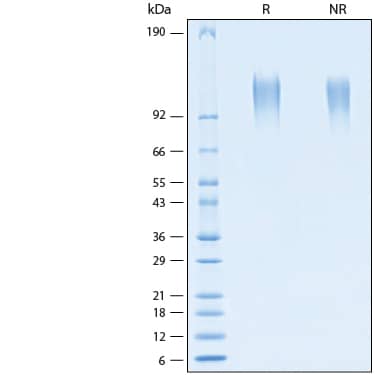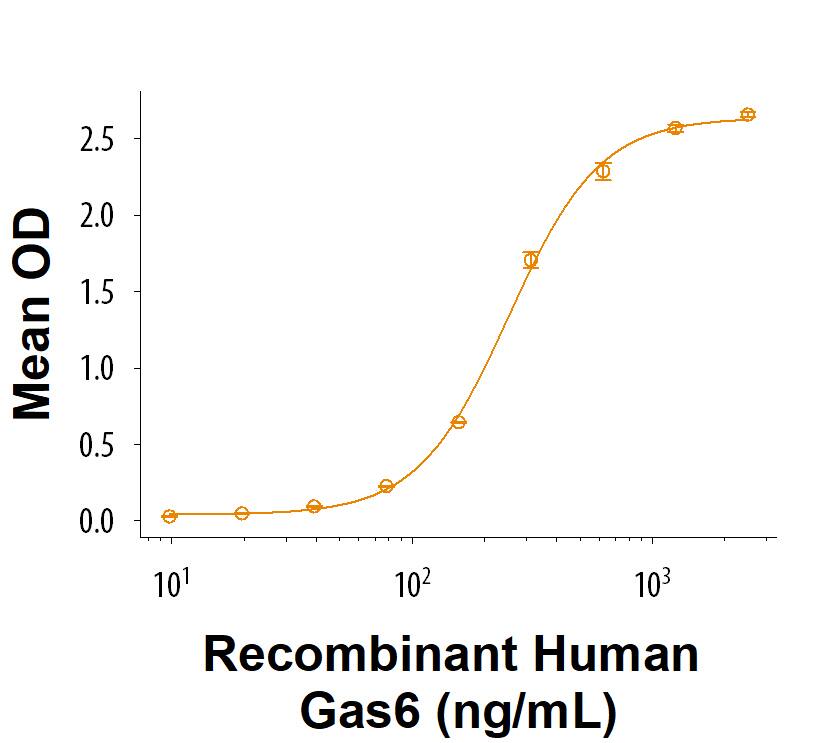Recombinant Human Mer His-tag Avi-tag Protein, CF
R&D Systems, part of Bio-Techne | Catalog # AVI10515
Biotinylated

Key Product Details
Source
HEK293
Accession #
Structure / Form
Biotinylated via Avi-tag
Conjugate
Biotin
Applications
Bioactivity
Product Specifications
Source
Human embryonic kidney cell, HEK293-derived human Mer protein
| Human Mer (Arg20-Asp500) Accession # Q12866.2 |
6-His tag | Avi-tag |
| N-terminus | C-terminus |
Purity
>95%, by SDS-PAGE visualized with Silver Staining and quantitative densitometry by Coomassie® Blue Staining.
Endotoxin Level
<0.10 EU per 1 μg of the protein by the LAL method.
N-terminal Sequence Analysis
Arg20
Predicted Molecular Mass
55 kDa
SDS-PAGE
108-121 kDa, under reducing conditions.
Activity
Measured by its binding ability in a functional ELISA.
When Biotinylated Recombinant Human Mer His-tag Avi-tag (Catalog# AVI10515) is captured on EvenCoat Streptavidin Coated Plates (Catalog # CP004) at 2.00 µg/mL (100 µL/well). Recombinant Human Gas6 Protein (Catalog # 885-GSB) binds with an ED50 of 80.0‑800 ng/mL.
When Biotinylated Recombinant Human Mer His-tag Avi-tag (Catalog# AVI10515) is captured on EvenCoat Streptavidin Coated Plates (Catalog # CP004) at 2.00 µg/mL (100 µL/well). Recombinant Human Gas6 Protein (Catalog # 885-GSB) binds with an ED50 of 80.0‑800 ng/mL.
Scientific Data Images for Recombinant Human Mer His-tag Avi-tag Protein, CF
Recombinant Human Mer His-tag Avi-tag Protein Binding Activity.
Measured by its binding ability in a functional ELISA. When Biotinylated Recombinant Human Mer His-tag Avi-tag Protein (Catalog # AVI10515) is captured on EvenCoat Streptavidin Coated Plates (CP004) at 2.00 µg/mL (100 µL/well), Recombinant Human Gas6 Protein (885-GSB) binds with an ED50 of 80.0-800 ng/mL.Recombinant Human Mer His-tag Avi-tag Protein SDS-PAGE.
2 μg/lane of Recombinant Human Mer His-tag Avi-tag Protein (Catalog # AVI10515) was resolved with SDS-PAGE under reducing (R) and non-reducing (NR) conditions and visualized by Coomassie® Blue staining, showing bands at 108-121 kDa.Formulation, Preparation and Storage
AVI10515
| Formulation | Lyophilized from a 0.2 μm filtered solution in PBS with Trehalose. |
| Reconstitution | Reconstitute at 500 μg/mL in PBS. |
| Shipping | The product is shipped at ambient temperature. Upon receipt, store it immediately at the temperature recommended below. |
| Stability & Storage | Use a manual defrost freezer and avoid repeated freeze-thaw cycles.
|
Background: Mer
References
- Graham, D.K. et al. (1994) Cell Growth Differ. 5:647.
- Graham, D.K. et al. (2006) Clin. Cancer Res. 12:2662.
- Shibata, T. et al. (2014) J. Immunol. 192:3569.
- Nagata, K. et al. (1996) J. Biol. Chem. 271:30022.
- Uehara, H. et al. (2008) J. Immunol. 180:2522.
- Caberoy, N.B. et al. (2010) EMBO J. 29:3898.
- Caberoy, N.B. et al. (2012) J. Cell Physiol. 227:401.
- Kim, S.Y. et al. (2016) Sci. Rep. 6:29673.
- Cummings, C.T. et al. (2013) Clin. Cancer Res. 19:5275.
Long Name
Receptor Tyrosine Protein Kinase Mer
Alternate Names
c-Eyk, C-mer, MerTK
Gene Symbol
MERTK
UniProt
Additional Mer Products
Product Documents for Recombinant Human Mer His-tag Avi-tag Protein, CF
Product Specific Notices for Recombinant Human Mer His-tag Avi-tag Protein, CF
For research use only
